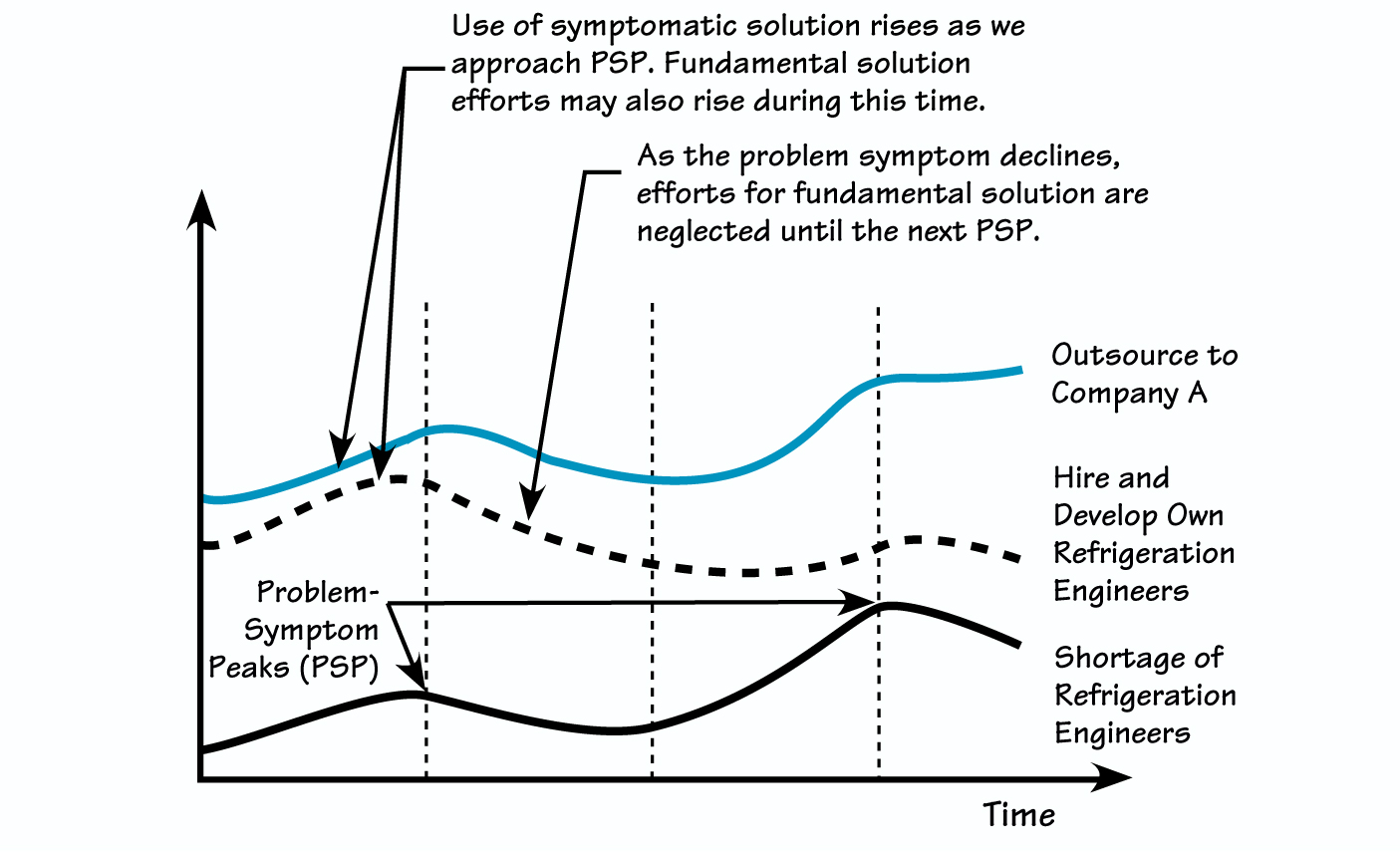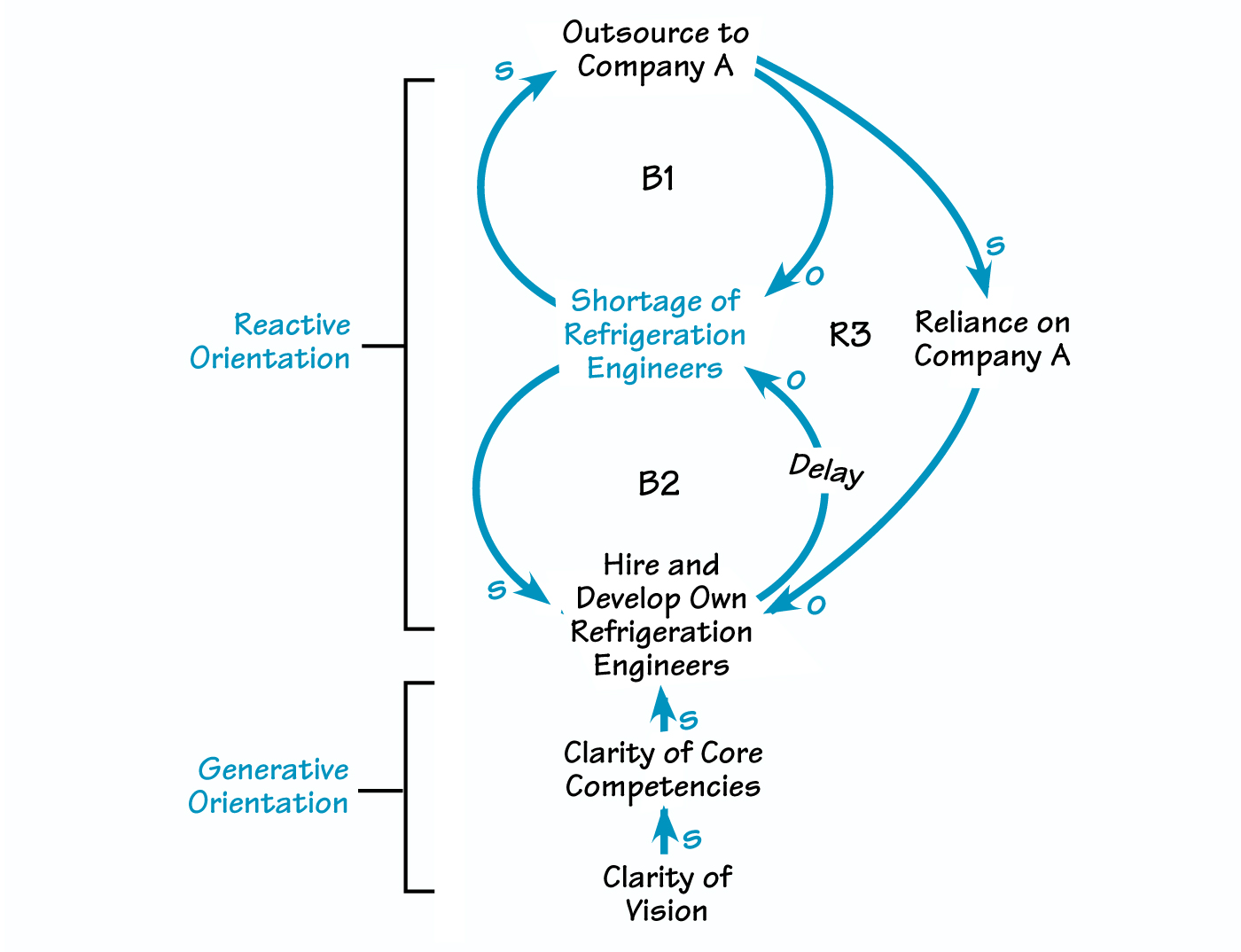Although the parable of the boiled frog has become a familiar story in organizational learning circles, it does not yet seem to prevent organizations from suffering the same fate. The story goes that if you toss a frog into a pot of boiling water, it will jump out to save itself. However, if you put it in a pot of lukewarm water and slowly turn up the heat, the frog will happily swim around until it boils to death. Not a pretty picture, especially if you don’t enjoy frog’s legs. So, why doesn’t the frog jump out in the second instance? The reason is that it is designed to detect sudden, large shifts in temperature, not small, gradual changes. So, it never senses the danger in the second scenario until it’s too late to respond.
As Peter Senge points out in The Fifth Discipline, many organizations suffer from the same learning disability as the frog. Their internal detection mechanisms are geared for responding only to quick, dramatic changes in their environment, not to slow, more incremental ones. Hence, the same businesses that would sound all kinds of alarm bells if they experienced a sudden 5-percent drop in market share will quietly adapt to an annual 0.5-percent erosion over 10 years without recognizing this slow downward spiral as a crisis.
Although the boiled-frog syndrome has often been associated with the “Drifting Goals” archetype, there are many ways in which an organization can “get boiled.” In the “Shifting the Burden” structure, things seem to improve in the short term, even as the water gets hotter and hotter over time. Therefore, this archetype warns us about the long-term consequences of relying on a symptomatic approach to addressing problems.
The Urgency of Now
The “Shifting the Burden” systems archetype produces behavior quite similar to that generated by the “Fixes That Fail” structure (see “Fixes That Fail: Why Faster Is Slower,” V10N3). Both archetypes tend to cause people to take actions in response to acute problems, and both tend to reinforce the use of quick fixes. In this way, the two archetypes are driven by the urgency of the here and now, which leads to unintended consequences that end up making the original situation worse in the future.
The difference with the “Shifting the Burden” archetype is that it requires a deeper understanding of what’s needed to keep the system healthy than does the “Fixes That Fail” structure. This is because addressing a “Shifting the Burden” scenario often necessitates identifying not so much a solution to a problem but rather the fundamental capability that the organization needs to develop over the longer term.
Prudent Outsourcing or Shifting the Burden?
Let’s look at an example. In “Boiled Through Outsourcing,” we see a situation in which a refrigerator manufacturer faces a shortage of engineers to work on a new product design (labeled “Problem-Symptom Peaks” in the diagram). Management knows that they need to add more engineers if the company is going to be able to handle these kinds of projects internally. But because they must begin work on the new product right away, they choose to outsource the engineering to Company A.
BOILED THROUGH OUTSOURCING

The manufacturer faces a shortage of engineers to work on a new product design (problem symptom). Management knows that they need to add more engineers (fundamental solution). But because they must begin work on the new product right away, they choose to outsource the engineering (symptomatic solution). The company repeats the same dynamics time and again, lessening its own internal capability.
At the same time, because company leaders recognize the need to build up their own staff, they initiate actions to hire and develop internal capacity. However, those efforts quickly wane when the problem symptom—the need for experienced refrigeration engineers—declines because Company A is doing such a good job. Other, more pressing issues occupy the company’s attention, and the capacity-building effort gets put on the back burner until the next staffing shortfall occurs. At that point, the company repeats the same dynamics.
This approach leads to a pattern of behavior in which the problem symptom continually resurfaces. Each time, the company makes efforts to address both the symptomatic and fundamental problems. However, when the quick fix proves successful in handling the problem in the short term, the organization continues to rely on that tactic over the longer run. As a result, efforts to seek a lasting, more fundamental solution decline. If left unchecked, the company will eventually “boil” like the poor frog— that is, face serious financial and performance difficulties.
Breaking Out of a Reactive Orientation
Although choosing to invest in the more fundamental solution is better than pursuing a symptomatic solution, both actions are inherently reactionary. This is because the two approaches are driven by the need to solve what is currently wrong rather than by the desire to create the future you want. Hence, even opting for the fundamental solution can produce problem symptoms that come and go. This is because no matter how the symptom gets reduced, the amount of effort devoted to its solution varies with the severity of the symptom—it rises when the problem is acute and falls when it is “under control.”
FROM A REACTIVE TO A GENERATIVE ORIENTATION

Breaking out of a reactive orientation requires shifting from problem-solving to developing a vision of what you want to create—a generative orientation.
Breaking out of this reactive orientation requires a shift from problem-solving to developing a vision of what you want to create—a generative orientation (see “From a Reactive to a Generative Orientation”). In our example of the refrigerator manufacturer, this approach would mean having a clarity of vision about the kind of engineering capability the company wants to maintain and then developing that skill base—regardless of whether the organization is experiencing shortfalls at the moment or not. The company may still experience problems with staffing shortages during this time. However, when it encounters them, the organization will be able to use symptomatic solutions as temporary stop-gap measures, while it continues to steadily build its underlying capacity.
Does our refrigerator manufacturing example mean that all outsourcing is a case of “Shifting the Burden”? The answer to that question depends on your organization’s vision of what it wants to keep as its core competencies. If you inadvertently ended up outsourcing what you considered a core competency, such as refrigeration design, then you would be caught in a “Shifting the Burden” dynamic. On the other hand, if you decided that competence in payroll systems and health-benefit programs was not key to your core business, outsourcing those functions might be a prudent decision.
Out of the Boiling Pot and . . .
The “Shifting the Burden” structure shows that, in addition to refining our organizations’ mechanisms for detecting slow, gradual changes, we need to develop better direction-setting systems. Otherwise, we may improve at making course corrections but never clarify what course we really want to take. That approach would be analogous to our poor frog jumping from one pot to another whenever it feels the water heating up, but never pur-suing a more fundamental solution by seeking a nice lily pond instead. Even with improved temperature-sensing mechanisms, if the frog keeps hopping from one pot to the next, the odds are that, sooner or later, it will end up on someone’s dinner plate.
Daniel H. Kim, Ph. D., is publisher of The Systems Thinker and a member of the governing council of the Society for Organizational Learning.
